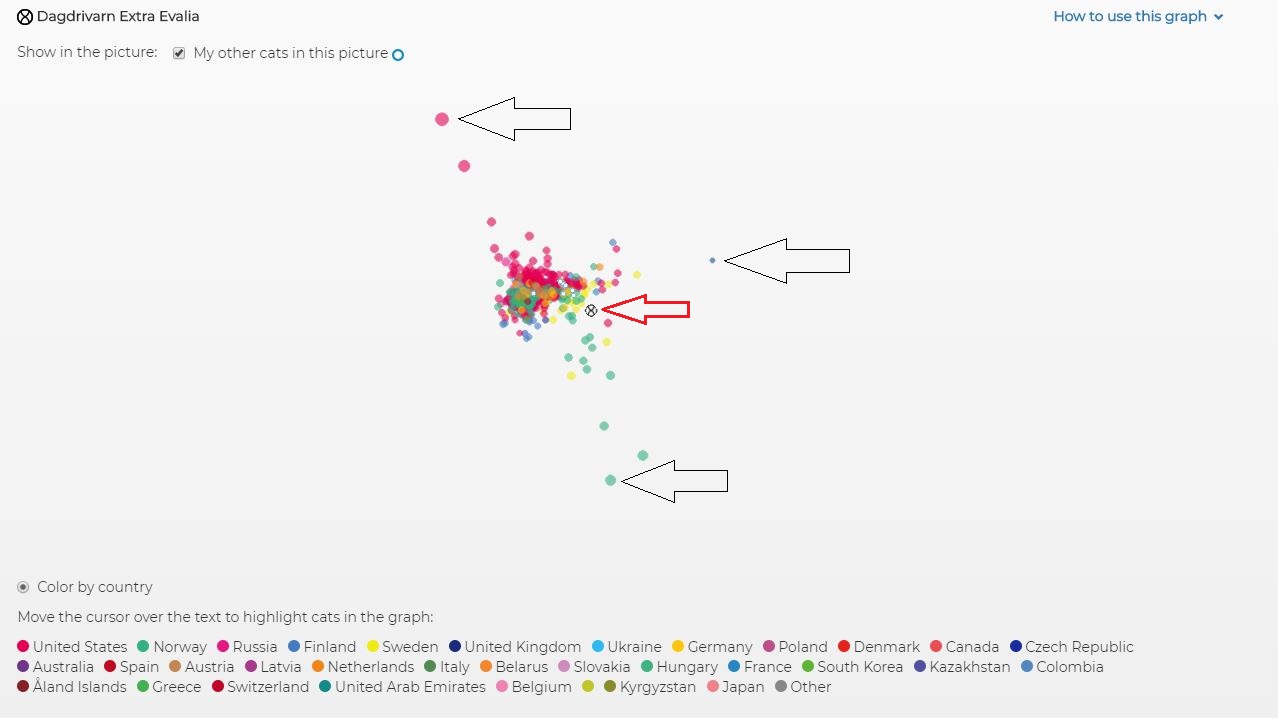Search, find, and work with New Foundation
As we all know the Maine Coon was founded in Maine and spread all over the US and also CA.
When we are looking for new blood to add to the breed nowadays, it’s important to know what to look for and what to avoid. When we are looking for new bloodlines the reason is to try to lower the genetics from the 17 siblings we know as the clones first and foremost. Therefore it’s really, really important that we can be as sure as possible that the cat we take in as New Foundation has no trace of purebred behind, but also that it's as healthy as possible.
In this article, I will write “New Foundation” - “NF” in short most of the time.
Search and Find
We do need to document carefully, as much as possible, of course, we cannot know everything. But we can make sure to document a lot.
What farm did the cat/kitten come from? (We should be careful use stray cats OR cats found in yards in suburban areas or cats found at shelters, since we have no clue, for all we know this cat/kitten could be a purebred that got lost, or a cat/kitten from two registered parents but who was breed by someone who does not have a cattery and does not bother to register their kittens. Which means those can very well be from a purebred background.
Earlier MyCatDNA/Optimal Selection had a very nice function, see below, that we could use, but they have removed it after the update.
Look at this picture, the little black dot with an X-mark with a red arrow is one of my females with really high genetic diversity, she is on the outer edge of the clusters and very unrelated to many other cats.
If you look at the black arrows you can see those cats are far away from the cluster in the middle, they are very unrelated cats and here somewhere is where you would suspect to find an NF you are testing if it’s closer to the cluster, well then you got your hands on a cat that most likely got a lot on MCO in it and as an NF it’s not worth much.
Who is the mother of the Cat/kitten?
The owner should at least know the mother of the cat/kitten.
Is there a particular male who hangs around that could be suspected to be the father, or have they seen any male lurking around that could be the father, for example cat from a neighbouring farm, etc.
What other cats are moving around in the areas?
Document as much as you possibly can with photos, questions to the owner of the farm.
The more information there is, the better it is. If the farmer can share information on several generations, that's even better.
Maybe the mother has both her mother and grandmother on the farm.
More documentation
If you are not living in the US yourself and are finding a New Foundation by yourself, make sure to publish proof of origin!
Such as Travel documentation, all the documentation signed by the veterinarian in the USA, making sure to get as much documentation as possible, photos from the original home, with the mother of the kittens, siblings, and all those kinds of things. It's not hard at all to show your cat's origin, this is something that is easily done by anyone who imported a cat.
Before travelling to Europe, the kitten you found, of course, needs to see the veterinarian several times, get two shots, get tested for FIV/FelV, full blood panel, get Flea treatment, get a chip, get a veterinary clearance, and get the passport. Just show all this kind of documentation, and then there is no need to question the origin of this cat.
A small warning, today with AI and all those things, falsifying a document can be very easily done if you are sent the documentation in a picture. If you have any doubts, please contact the veterinarian in question to make sure this cat was in fact there. Also, check the travel documentation to make sure it's legal.
Work with New Foundation
Today, we need a LOT of New Foundation lines to help the breed become healthier and stay healthy. This means that we all need to help each other, just getting an NF yourself and mixing it with your own show lines that have a really high COI above 10-15% is not helping the bigger picture.
You can still register for F1 with ACA. Below is an explanation of what F1 to F5 means.
An F 1 is a first-generation Maine Coon foundation cat. This cat can be found in the wild, on a farm, or can be obtained from a private home or shelter. None or only one parent of an F1 is known and registered.
F1 - Is a first-generation Maine Coon foundation cat, none or only one of the parents of an F1 is known and registered. Those cats might have been found in the wild, on a farm, or obtained from a private home or a shelter.
F2 - Is a second-generation Maine Coon Foundation cat, both parents are known and registered but behind them, one or both are F1 (see above).
F3 - Is a third-generation Maine Coon foundation cat, both parents and grandparents are known and registered, but one or all of the grandparents are F1 (see above), one or more of the parents are F2 (see above).
F4 - Well, you see what this leads here, the F1 cat will be found in the fourth generation.
F5 - This cat now has a full pedigree and the F1 cat/cats behind it will show first in the fifth generation.
I will explain why if you look below.
When you find an F1 to work with, think carefully about what you are doing. I read a quote a long time ago.
If you think of the existing gene-pool (the show lines) as a glass of water, and the NF-cats are blueberry essence to give the water taste and colour.
 |
 |
 |
 |
 |
| At first, you got the normal population of MCO. Without any NF added, just pure water. | Then you add a bit of blueberry essence, and you get a nice color and a good taste. | After this, you continue to add another glass of water to the mix, and the mix will be a bit paler and less tasty, a bit flat. | Then you add yet another glass of water, now the color is visually paler and the taste is really flat, almost gone. | You then add yet another glass of water, and the essence will be almost non-existent, everything from the essence you put into the first glass would be almost gone, diluted into nothing, it would get lost in all the water. |
This scenario above is what happens if you add a new foundation to the existing population and then keep adding show lines over and over again; all the work you put into a new foundation would be for nothing!
If you get an F1 but then continuously keep mating it to the existing population instead of breeding, keeping it dark blue and tasty, you might add some water, but then you add a bit of essence again, add water, and then essence. You get more essence you can easily mix the essence with essence (mate NF with NF and NF to Outcross to build new breeding lines with NF).
If you do get a nice NF line, make sure to spread the kittens, in normal cases we never let more than 1-2 kittens go to breeding from a litter, in those cases, we might rather let more kittens go to breeding but make sure that none of them gets too many litters each, and also that the lines are spread around the globe so that some are in the US, some in the south of Europe and some in Northern Europe and so on…. It's better to have more NF cats than to overuse a few.
There is a lot of work involving breeding NF-lines but it’s worth it in the end. A lot of breeders in Europe are in desperate need of NF-cats, but they are hard to get these days.
A lot of breeders who worked with NF are nowadays mixing them with show lines, what we want and need are pure NF-lines and pure NF cats without show lines behind.
Health
One thing that is of the highest importance is to really, really test both our new NF cats but also their offspring and the offspring after that so that we quickly react IF we discover some unwanted trait.
First of all, of course, you need to do a full bloodwork, look for all kinds of sickness like FIV/FelV, an eye-packed to check for viruses and other diseases, you need to make sure there are no fleas, and so on.
- Full DNA Screening by MyCatDNA/Optimal Selection - You've got to know ALL possible diseases to see if the cat/kitten might carry something known in another breed or in the MCO.
- Make sure to do the X-ray at 10 months within the health program (everyone can easily test within the health program since any veterinarian is allowed to perform the X-ray and send it into the health program).
- Check for patella also when doing the X-ray; we can never be too careful.
- Make sure to do heart screenings to check for HCM at 1,2,3 and 5 (if you are able to find a veterinarian connected to the health program that is the best, but if you at least do the test and/or if possible get your veterinarian to apply to be connected to the health program).
- When doing the first HCM, also check for PKD just to be sure.
Do not forget that when you had the first litters that we should also make sure the cat is fit as a breeding male/female in all other areas, like for example.
- How is the temper?
- Do the kittens have normal birth weights
- Are there low neonatal mortality rates
- Does she have easy births
- Does she have normal milk production
- No signs of cannibalism or abandonment
By: Malin Sundqvist










